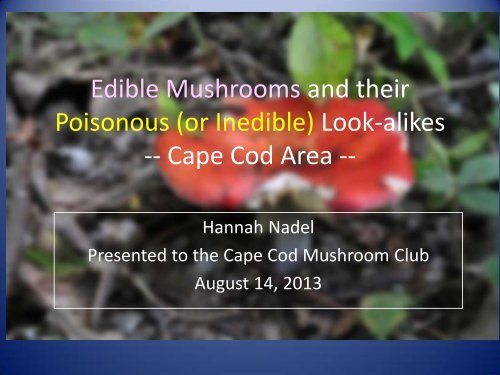Mushroom_Look_alikes_on_Cape_Cod_-Hannah_Nadel.pdf 2.4 MB
Mushroom_Look_alikes_on_Cape_Cod_-Hannah_Nadel.pdf 2.4 MB
Mushroom_Look_alikes_on_Cape_Cod_-Hannah_Nadel.pdf 2.4 MB
Create successful ePaper yourself
Turn your PDF publications into a flip-book with our unique Google optimized e-Paper software.
Edible <str<strong>on</strong>g>Mushroom</str<strong>on</strong>g>s and theirPois<strong>on</strong>ous (or Inedible) <str<strong>on</strong>g>Look</str<strong>on</strong>g>-<str<strong>on</strong>g>alikes</str<strong>on</strong>g>-- <strong>Cape</strong> <strong>Cod</strong> Area --<strong>Hannah</strong> <strong>Nadel</strong>Presented to the <strong>Cape</strong> <strong>Cod</strong> <str<strong>on</strong>g>Mushroom</str<strong>on</strong>g> ClubAugust 14, 2013
C<strong>on</strong>t’d• Alcohol inky.................• Meadow <str<strong>on</strong>g>Mushroom</str<strong>on</strong>g> &relatives.........................• H<strong>on</strong>ey <str<strong>on</strong>g>Mushroom</str<strong>on</strong>g>.........• Puffballs.........................• Chicken of the Woods....• Alcohol inky + booze• Iodine-scented Agaricusspecies, Pois<strong>on</strong> Pie• Pois<strong>on</strong> Pie, DeadlyGalerina• Earthballs, Amanita eggs• When <strong>on</strong> c<strong>on</strong>ifersPlus Miscellaneous cauti<strong>on</strong>ary notes
Note <strong>on</strong> photo credits:• Unless otherwise noted, credited photos are fromWikimedia Comm<strong>on</strong>s (free use).• No credits: my photos.Note <strong>on</strong> abbreviati<strong>on</strong>s:• SP = Spore print color• Species abundance in New England:• C = Comm<strong>on</strong>• FC = Fairly comm<strong>on</strong>• O = Occasi<strong>on</strong>al• Name or notes in yellow: warning.• Note in pink: edible species.
King Boletus, Cep, PorciniBoletus edulisSP olive-brownCHOICE EDIBLEFCGrows in woods, especially c<strong>on</strong>ifers.Photo: DezidorPhoto: User:Strobilomyces
White reticulati<strong>on</strong>(netting) at least atthe top of the stalk.
Bitter-tasting boletesBitter boleteTylopilus felleusPores pinkish in ageOrnate-stalked BoletusB. ornatipes, sometimesbitterStalk, pores stain orangePhoto: bernd gliwaMycoweb.com
Two pois<strong>on</strong>ous boletes: Gastrointestinal upsetBoth have red parts; all parts stain bright blue when cut or bruised1. Boletus sensibilisSP olive-brown.B. sensibilis (butt<strong>on</strong>)Photo: Kira (Kiradee) at<str<strong>on</strong>g>Mushroom</str<strong>on</strong>g> ObserverGrows underhardwoods.Photo: Hugh Urban atwww.morelmushroomhunting.comO to FC
2. Red-mouth BoleteBoletus subvelutipesSP dark olive-brown.Photo: the3foragersFCRed pores when young.Grows underhardwoods, esp. oaks.Photos: Dave W.
Golden Chanterelle(Cantharellus cibarius)CHOICE EDIBLEGrows <strong>on</strong>ground inwoods.SP pinkishcream to palebuff.FCGill-likeridges, blunt.Odor mild tofragrant,apricot.Photo: Игорь Лебединский
False chanterelleHygrophoropsis aurantiacaSP white.Jack-o-LanternOmphalotus oleariusSP whitish cream.True gillsFCPhoto: W.J.PilsakGrows <strong>on</strong> c<strong>on</strong>ifer debris.Reported hallucinati<strong>on</strong>s possiblydue to c<strong>on</strong>fusi<strong>on</strong> withGymnopilus spp.; flavor blah.FCPhoto: Ant<strong>on</strong>io AbbatielloGrows <strong>on</strong> hardwood trees, stumps.St<strong>on</strong>g gastrointestinal upset.
Several red brittle caps of unknown edibility or... worseBrighter red capTaste acrid, bitter, or blandUnidentified Russula& other variati<strong>on</strong>s <strong>on</strong> the theme ofred-capped russulasEmetic RussulaRussula emeticaSP creamy, pale yellow.Stalk white.Taste ACRID.Causes vomiting.R. pseudolepidaSP yellow-creamuncomm<strong>on</strong>R. rubescensSP ochreuncomm<strong>on</strong>Just avoid the red <strong>on</strong>es...
Short-stalked White RussulaRussula brevipes EdibleSP white to pale cream.Taste not distinctive.Grows under hardwoods/c<strong>on</strong>ifers.Photo: Joseph O'Brien, USDA ForestService, Bugwood.orgCFunnel-shaped, large,white brittle capsBad-tasting:1) R. brevipes has an acridtastingvariety!Bluish-green tinted gills & stalkapex.2) Russula vesicatoria3) Russula piperatus& OthersSP dark creamTaste acrid, bitter.
Lobster <str<strong>on</strong>g>Mushroom</str<strong>on</strong>g>Hypomyces lactifluorum parasitizingbrittle caps or milk caps (the “host”)CHOICE EDIBLECauti<strong>on</strong>:• Know the host mushroom.• Check unparasitized specimensin the vicinity to c<strong>on</strong>firm host.• May grow <strong>on</strong> a mildly upsettingmilk cap or <strong>on</strong> Emetic Russula?Usually masks acrid flavor of host.Photo: Joe Mabel
Gypsy <str<strong>on</strong>g>Mushroom</str<strong>on</strong>g>Cortinarius (Rozites)caperatusGrows <strong>on</strong> groundSP rusty brownRing is membranous1) Yellow Gymnopilus- PsychoactiveGymnopilus luteusGrows <strong>on</strong> tree stumps, logsSP yellow-orangeRing is webbyGood ediblePhoto: StrobilomycesCPhoto: Dan Moltor
2) Laughing Gym (Jim)Gymnopilus jun<strong>on</strong>ius(spectabilis)Psychoactive(psilocybin)SP rusty brown.Ring is webby.GypsyGrows <strong>on</strong> tree stumps, logs.Both Gymnopilus may appearto grow <strong>on</strong> the ground if <strong>on</strong>buried wood.Photo: T<strong>on</strong>y Wills
Pine mushroom, American MatsutakeTricholoma magnivelareGrows <strong>on</strong> ground, c<strong>on</strong>ifers/hardwoodsCHOICE EDIBLESP white.Odor “dirty gymsocks”, sweet-spicy,fruity.Thick white cott<strong>on</strong>yveil/ring.Gills attached t<strong>on</strong>otched.FCPhoto: Ryane Snow at<str<strong>on</strong>g>Mushroom</str<strong>on</strong>g> Observer
White Amanitas, likeDestroying AngelAmanita virosaDeadly! Amanitin toxinkills liver cells.Under oaks.SP white.Odor not distinctive.95% ofmushroomfatalities in USare due to whiteamanitas!Volvapresent.Pine mushroomGills free of stem or very finelyattached.Veil not cott<strong>on</strong>y, higher <strong>on</strong> stalk,often disappears.
EdibleTree volvariellaVolvariella bombycinaSP pinkish.Free gills, no ring.Volva.Grows <strong>on</strong> live or deadhardwood trees, logs.OPinkish gills, spores, andlack of ring separateVolvariella from Amanita.Photo: Hagen Graebner
Blewit EdibleClitocybe nudaSP pinkish tanGills notched to sinuate.Viscid Violet CortCortinarius iodesCAUTION: May be pois<strong>on</strong>ous(l<strong>on</strong>g-term c<strong>on</strong>sumpti<strong>on</strong>?)SP rusty brown.Gills attached, lilac/violet whenyoung.FCGrows <strong>on</strong> ground in woods,meadows, lawns, plant residues.FCGrows <strong>on</strong> ground underhardwoods.
H<strong>on</strong>ey <str<strong>on</strong>g>Mushroom</str<strong>on</strong>g>Armillaria meleaSP pale cream.Edible when thoroughly cooked.Gills attached tosubdecurrent.CGrows in clusters at baseof trees or stumps.Photo: Stu PhillipsPhoto: at Mykoweb
Deadly GalerinaGalerina marginata (autumnalis)Deadly! Amanita toxins. Causes liverand kidney damage.SP rusty brown.Grows <strong>on</strong> decayingwood.Gills attached tosubdecurrent.Cap small (to 2.5”).Stalk with ring.Photo: LebracFC
Pois<strong>on</strong> PieHebeloma crustuliniformeCauses gastrointentinaldistress.SP yellow-brown, brown.Gills notched.Photo: rain at <str<strong>on</strong>g>Mushroom</str<strong>on</strong>g>OberverGrows <strong>on</strong> ground inwoods.FCPhoto: www.stridval.seGills edged withwhite; finely notched;with brown dropletswhen fresh.
Several Agaricus speciesGood ediblesCauthi<strong>on</strong>: GI upsetfrom Agaricusspecies that smelllike phenol (ink,iodine, medicinal,unpleasant)Meadow <str<strong>on</strong>g>Mushroom</str<strong>on</strong>g>A. campestrisHorse <str<strong>on</strong>g>Mushroom</str<strong>on</strong>g>A. arvensisPhoto: Nathan Wils<strong>on</strong>Agaricus placomyces
Sulphur Shelf, Chicken <str<strong>on</strong>g>Mushroom</str<strong>on</strong>g>Laetiporus sulphureusAnnual. Grows <strong>on</strong> dead trees, logs.Pores yellow.CHOICEEDIBLE Cauti<strong>on</strong>: maycause GI upsetwhen grows<strong>on</strong> c<strong>on</strong>iferwood.FC
PuffballsLycoperd<strong>on</strong>CalvatiaGood Edibles when youngCFCPear-shaped puffballLycoperd<strong>on</strong> pyriformeand other species.When older -- soft like amarshmallow or no l<strong>on</strong>ger whiteinside -- taste and texture are nol<strong>on</strong>ger desireable.Giant Puffball, Calvatia gigantea, and other species.
EarthballsScleroderma- Pois<strong>on</strong>ous.Spore mass grayish,turning black or purpleblack.Root-like structures.Amanita “egg”Deadly, if deadlyspecies!Outline of mushroomvisible when cut.
Alcohol InkyCoprinus atramentariusSP black.Gills free, crowded.Edible but avoid alcoholwithin 48 hours!Alcohol c<strong>on</strong>sumpti<strong>on</strong> causesflushing; swelling andnumbness of hands and feet;rapid heartbeat; vomiting.VCGrows inclusters <strong>on</strong>grass, woodchips, treebases.
Photo: Matthias RennerMan-<strong>on</strong>-HorsebackTricholoma equestre (wasflavovirens)SP white.Gills notched.On ground inc<strong>on</strong>ifers/mixed woodsTraditi<strong>on</strong>ally a choiceedible, now with cauti<strong>on</strong>!
Quiz: What is this edible mushroom growing <strong>on</strong> wood chips?SP Purple-brownPhoto: Ann F. BergerFCAnswer <strong>on</strong> next slide
(Answer to quiz <strong>on</strong> previous slide:Wine-Cap StrophariaStropharia rugosoannulata)The End


